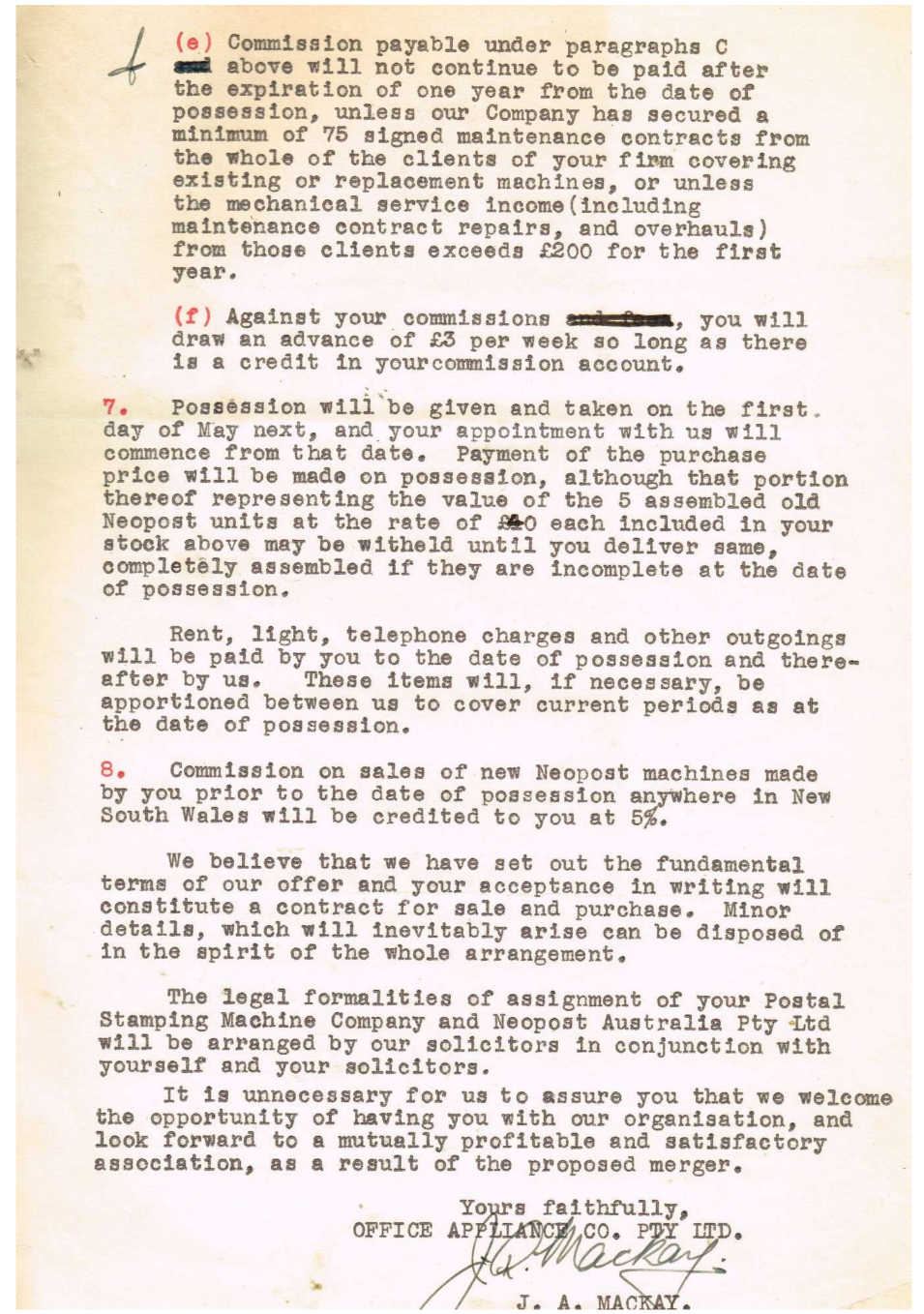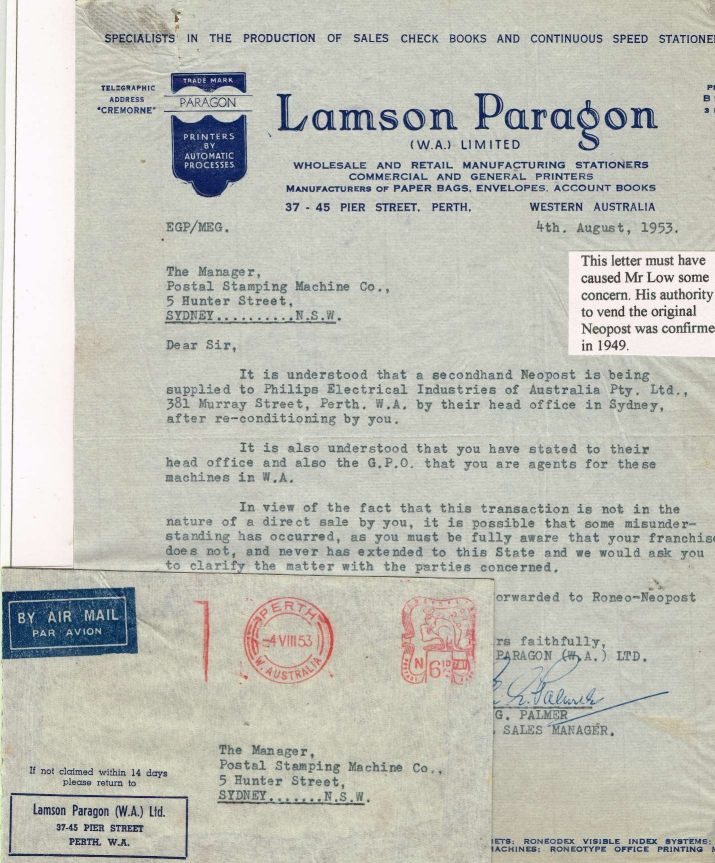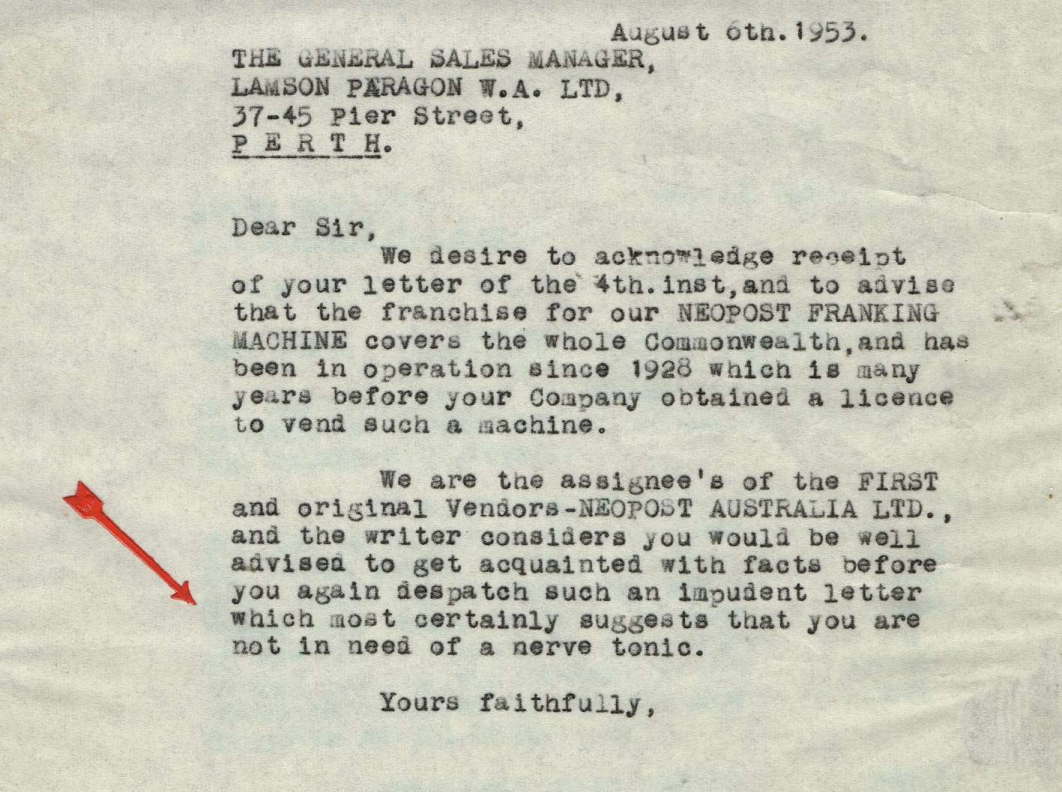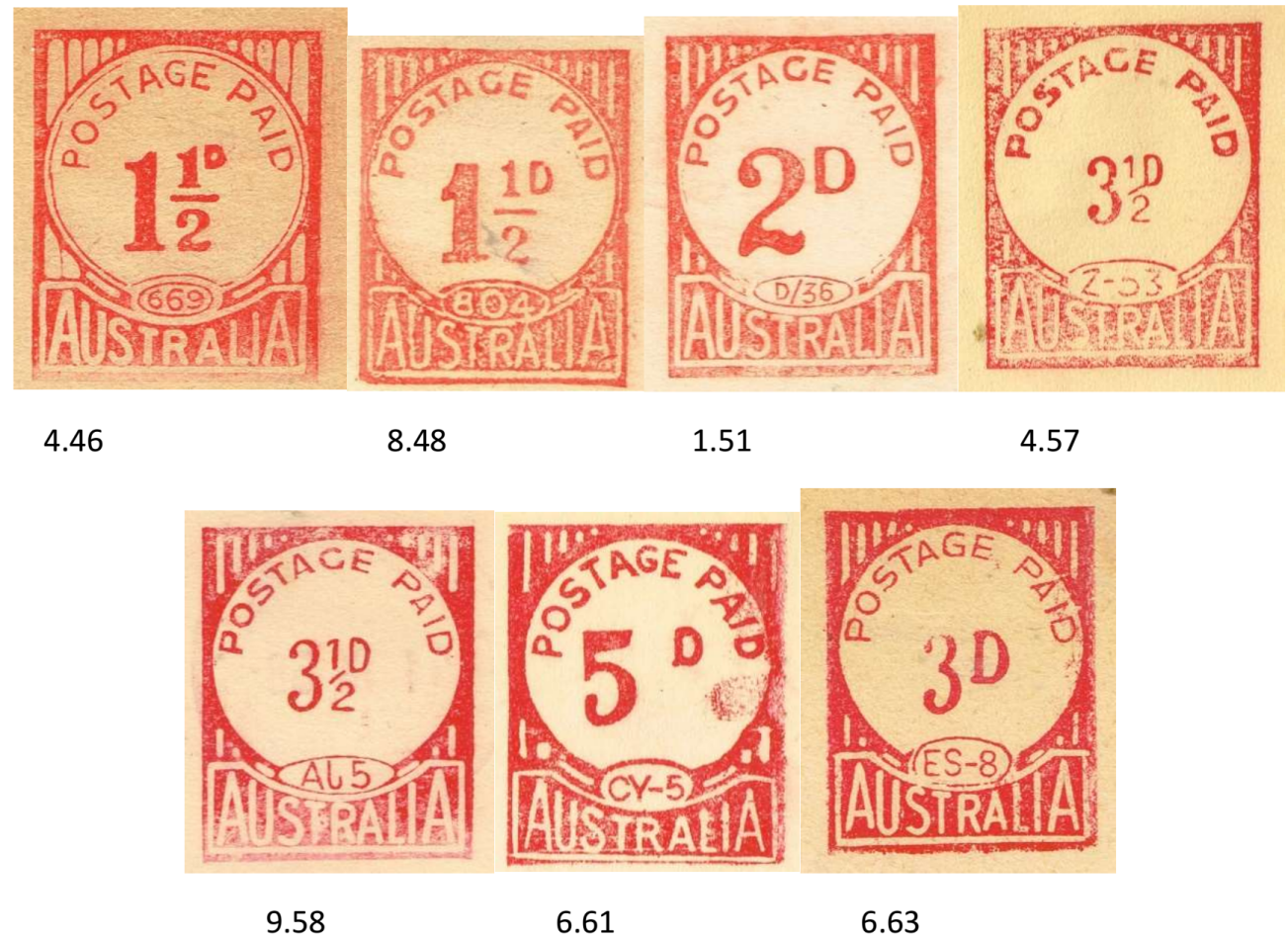A Study of the Frank Dies Used on Early Neopost Franking Machines in Australia
by: Richard C Peck ACCF, MAP
Can you remember what the main distinguishing features of the various die states are on Ausralia’s kangaroo and map stamp series? Using the same detective skills acquired from studying many kangaroo stamps, let us examine the various dies used on this iconic meter design.
There are several parts of a franking machine. (1) the frank die which is the property of the post office and must be surrendered when the machine is no longer used, (2) the postmark die, and (3) an optional advertising slogan or return address (both 2 & 3 are your property).
A franking machine must be licensed by the post office and only sold and serviced by an approved vendor. No machines have ever been made in Australia which has never had the industrial or economic depth to sustain such a fringe industry.
Several die types have been identified and will be designated Die 1, Die 2 etc.
The original Neopost “fixed value” machine was invented in London by Frank Langdon in 1925 and contained a value engraved on the frank die. Six machines were shipped by International Neopost Ltd to Sydney in 1927 and sold by Neopost Aust. Ltd. These all are Die 1.

Figure 1.
Soon after in 1928, an improved “limited value” model came out which could have either one, two, or three values which were on a tumbler and fitted into the frank die. These are also Die 1, made in the UK.

Figure 2.
The first question is: was there any difference between the dies used on these two types of machines?
Luckily for us, one machine (D7) was licensed to the North Shore Gas Co (the ancestor of today’s AGL). When the postage rates increased in August 1930, they traded this in on the newer model.
Looking at the following characteristics, can you spot any differences?
- The lettering of the word AUSTRALIA (this and the next engraved when the die was made in the UK).
- The spacing of the words POSTAGE PAID, paricularly the inital P and E.
- The shape of the space containing the licence number (which was engraved here).

Figure 3. Neopost 1 fixed value (top 2 rows) and 3 value limited value (bottom row)
Unfortunately, Neopost Australia Ltd went broke in the depression in 1931 and the stock of machines on hand were stored with Stott & Underwood Ltd (mainly typewriter and accounting machine sales). In 1937, Basil C Low bought this stock and set up as the Postal Stamping Machine Co. A number of frank dies would have come with this transaction but would eventually run out.
Do we now know from examining dies exactly when Low took over? Low sent his son David (later a radio announcer) to Melbourne to sell machines, hence the numbers coming from there at this time. Specimens from Low are known from August 1938 including our old friend D7. He took some time to adjust the backlog of orders received by Stott & Underwood before selling his first machine 424 in November 1938.
In the meantime, the original Neopost Australia agents appointed in Western Australia (Lamson Paragon Ltd) began to sell a further improved model (with 6 values). They traded in a 2 value machine (R3) for a 6 value model by October 1937 and apparently had a locally made die fitted.
- R3 an original Neopost 3 value from 1928. Looks like it became a 6 value in 1937. Was replaced by definite 6 value dies in 1940 (which in the 1941 conversion show as “2d½” and also a distinctive style of state name as “W.Australia”).

Figure 4. R3 showing the original 3 value and 6 value type in 1937 and again in 1940.
From 1938 and for a while even sold machines outside of WA. You can tell these dies because they were imported from Britain and had the following characteristics: as Die 2
- Long centre prong of E.
- Shorter P in POSTAGE.
- Vertical shading centered over I of ALIA.

Figure 5.
In a strange twist, Low actually had a hand in servicing some of these machines:
- RNE1312 originally sold to Lever Bros licence 486 in 1940. Low designed several slogans and when they upgraded in 1954 bought the machine for £2!
- RNE1313 originally sold to Yellow Express in 1941 as licence 514. Low did the 1951 conversion of values.
- RNE1314? Sold in WA in 1940 as possibly licence 516. In 1950 New Zealand Insurance (customers of Low) sent this machine to him to be licensed for their Perth office as C77. The values have varying styles of English bars under them. Later in 1959, Lamson Paragon did that conversion using English style values. (see C77 in the list below).

Figure 6. Low made slogans for 486 and also converted it several times. Note the strange shape of “2½“.

Figure 7. The original letter of sale for 486.

Figure 8. The bill of sale to Low.

Figure 9. Low prepares to convert 486 and 514 in 1951. The tumbler from 486 is shown.

Figure 10. Problems encountered when converting 514 (Australian Archives).
Here are the histories of the other identifiable 6 value machine. Note that in 1941 some machines had values converted from 1d to a penny halfpenny by adding the ½ after the ‘d’ (others did not). Later conversions (1956 and 1959) show evidence of value tumblers imported from the UK.
- 338 an original 2 value from 1941-1942, became a 6 value in 1951-1960, then replaced by a kangaroo die from until replaced by YH1 in 1966.

Figure 11. 338 as a 2 value then a 6 value.
- 347 originally a 2 value from 1937-1945, to a 6 value 1948-1956.

Figure 12. 347 as a 2 value then a 6 value.
- 417 originally a 6 value from 1940 (one copy seen), traded in on a Universal with the same number by 1942.

Figure 13. The only known copy of 417 as a 6 value.
- 431 originally a 6 value from 1938, with new dies in 1949 and replaced by kangaroo dies in 1956.

Figure 14. 431 as a 6 value, upgraded in 1950.
- 458 an original 6 value from 1940 with new values in 1950.

Figure 15. 458 as a 6 value (note correct 2½d;).
- 510 6 value 1941-1959.

Figure 16.
- 516 value seen only in 1942-1943

Figure 17.
- 543 6 value? Seen only 1951-1952.

Figure 18.
- 583 6 value 1944-1954.

Figure 19.
- 590 6 value known 1944-1945 (note: “No.590”).

Figure 20.
- 652 6 value 146-1952.

Figure 21.
- 680 6 value 1947-1950, 1950-1957.

Figure 22.
- 689 6 value 1947-1959 (but Die 1). 5d is English type value.

Figure 23.
- 718 6 value 1948-1956.

Figure 24.
- 735 6 value 1948-1956, smaller “735” (new fd) 1959-1960.

Figure 25.
-
781 6 value Neopost used by Lamson Paragon Ltd 1949. Kangaroo die 1950, new dies 1959-1965. (see letters).
-
928 a 6 value (probably a trade-in) from 1952. Note the different values (compare C77).

Figure 26.
- C36 parcels machine with values 3d 6d 9d 1/- 2/- 4/-, later 1d 2d 3d 6d 1/- 2/- 1953-1964.

Figure 27.
- C77 6 value 1951-1965, converted by Low 1957, converted by Lampson Paragon 1959.

Figure 28. Only some values show a bar below value from Low’s 1957 conversion.

Figure 29. (Photos J Ashby)
In 1946 Lamson Paragon tried to set up nationally The Office Appliance Co Ltd, but this failed. They then tried using the name Bell Punch which was then transferred to their international name Control Systems in 1948. That company lasted until 1971, initially using Neopost 6 value machines from licence 720 with a new die, Die 3. Some were engraved colourless on red, another had “No.753”. They were replaced by 1948 with an 8 value model, usually using the kangaroo die with no box around the “N” code.

Figure 30. The only remaining Neopost die in existence, ex Control Systems.753 used from 1948-1962.

Figure 31.
In 1948 Low approached The Office Appliance Co:

Figure 32.



Figures 33 - 35.
In 1949 Roneo Neopost of London accused Low of infringing patents but he won the battle as he could prove that the original Neopost rights were signed over to him. After that, he added features to rebuilt machines and gave these an “A” prefix. When in 1953 Low converted Philips’ machine, the following exchange of correspondence occurred:

Figure 36.

Figure 37.

Figure 38. Low several times re-used old dies soldering on the new licence number. These appear throughout the regular series below.
At this stage both Lamson paragon and Control Systems were in direct competition with Low who continued to have dies made (probably here in Sydney) for his original 1-3 value models as Roneo Neopost in the UK had replaced the old design with the kangaroo by then.

Figure 39. Note that the engraver has wrongly engraved “AJ5”. It was corrected before use.
It should be pointed out that by this time licensing was done by state batches of licence numbers. Here I have chosen NSW examples only. Also 1 value machines (such as CY5) sometimes had the die engraved with the value on it which is why they are different. (Here Low has used a converted 5½d tumbler for the engraver to use!).
I purchased my first machine (41D) from him in 1968 just before he sold The Postal Stamping Machine Co to TAC Pty Ltd, then agents for the new French SATAS machine. They continued until 1979 when the post office compulsorily delicensed all the remaining 1-3 value machines. I gave my machine to the Powerhouse Museum in 1996 and its dies remain within it to this day.

Figure 40. 11V used 1968-1970 in the TAC control period. (In this series 15V was mistakenly engraved V15t!)..
Acknowledgement: I gratefully acknowledge the assistance of Ian Fuary in this research.
